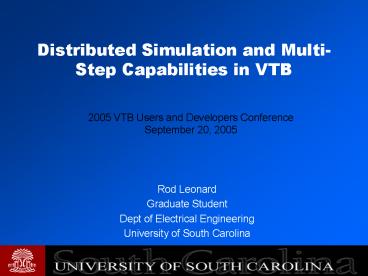Distributed Simulation and MultiStep Capabilities in VTB - PowerPoint PPT Presentation
1 / 25
Title:
Distributed Simulation and MultiStep Capabilities in VTB
Description:
Beowulf clusters. Other features. 3. VTB Architecture. Resistive ... Beowulf Cluster. When different processes are assigned to separate computers ... Beowulf Cluster ... – PowerPoint PPT presentation
Number of Views:29
Avg rating:3.0/5.0
Title: Distributed Simulation and MultiStep Capabilities in VTB
1
Distributed Simulation and Multi-Step
Capabilities in VTB
2005 VTB Users and Developers Conference September
20, 2005
- Rod Leonard
- Graduate Student
- Dept of Electrical Engineering
- University of South Carolina
2
Overview
- New Virtual Test Bed architecture
- Non-uniform time stepping
- Distributed Simulation
- Shared memory
- Beowulf clusters
- Other features
3
VTB Architecture
Schematic Editor
Schematic Editor
Math Engine
thr1
thr2
thr3
4
VTB as Multi-Solver Environments
Solver 2
Solver 1
Schm 1
Schm 2
- Focus switching
- Context switching
- Hierarchy of models
- System matrix order change
5
Database
- Database interaction occurs on a plugin-based
system - Any SQL relational database can be supported if a
compatible plugin is developed - First supported database will be PostgreSQL
6
Database, cont.
- Contents
- All registered computers and their addresses
- Schematic information
- Full state information for every time step of a
simulation - All viewables from a simulation
7
Simulation Backend
- Advantages
- Parallelism
- Increased Robustness
- Disadvantages
- Network delay
- Database Overhead
8
Client Connection
- Advantages
- Visualization modes available to any solver
- Multiple clients may connect to the same
simulation
9
Non-Uniform Time Stepping
- Motivation
- In a complete system simulation, some parts of
the system may have a much faster response time
than others, for example, an electrical control
and a mechanical plant - Instead of stepping the entire system at the
lowest time step, we may separate the system into
separate subsystems according to stepping
requirements
10
Example System
11
Separated System
12
Information Exchange
- Zero order hold
- Always used when extracting information from a
simulation running at a lower time step - Average
- Available for use when extracting information
from a simulation running at a higher time step
13
Future
- Predictive algorithms
- Methods to predict values for interim time-steps
from a simulation running at a higher time step - Nature coupling
- Methods to perform non-uniform stepping with
nature coupling
14
Distributed Simulation
- Shared Memory
- Multi-threaded operations concerning matrix
operations occur in each solver process - When multiple solver processes are assigned to
the same computer - Beowulf Cluster
- When different processes are assigned to separate
computers
15
Shared Memory
- Used automatically within a single solver
- Solver divides system calculation in multiple
threads - SMP systems are also taken advantage of
automatically when system when running in
non-uniform time step mode where multiple parts
are being run on the same computer
16
Beowulf Cluster
- Computations may occur in parallel in different
computers by assigning different parts of the
simulation to different computers - User determines how to divide simulation
- Advantages should be seen when running in
non-uniform time-step modes
17
Mixed Architectures
- Supercomputer
- Server farms
- Workstations
18
Future
- Solver will automatically use computer clusters
for internal matrix operations, similar to the
method used with shared memory - Availability to divide a simulation in different
parts without breaking the schematic into
different parts
19
Other Features
- Multiple-steps rollback features
- Control of simulation backend via web browser
- Separation of systems within the same schematic
- Added network communication features to allow for
better cooperation between engineers at separate
physical locations
20
Network Cooperation
- One engineer creates an overall system schematic
- Another creates a detailed section of a subsystem
- Each can perform their simulation over the
network making pseudo real-time changes and
observing only their area of interest.
21
Network Cooperation
- Saved viewable preferences
- Real-time communication
- Tracking of changes
22
Multiple-Step Rollback
- Database has full simulation information
- Ability to roll back to any previous point in the
simulation
23
Web Interface
- From any computer / architecture
- Schedule commands
- Access saved content
24
Easier System Separation
25
Current Status
- Signal coupled non-uniform time step systems
- Done
- Shared memory parallelism
- Done for uncoupled systems
- Cluster parallelism
- 90 done for non-uniform time-step systems
- Multiple step rollback
- 35 done
- Other features to be implemented































